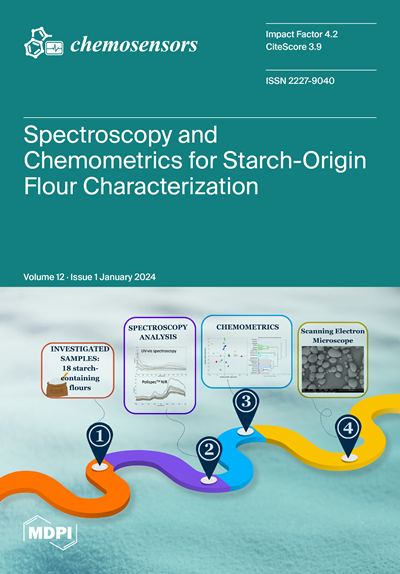在WO3·2H2O纳米叶片上直接水解Mesitylcopper (I)制备CuWO4@WO3 n-n异质结的气敏性能
IF 3.7
3区 工程技术
Q2 CHEMISTRY, ANALYTICAL
引用次数: 0
摘要
通过在WO3·2H2O纳米叶片上直接水解甲基铜(I),制备了纳米级Cu2O@WO3·H2O复合材料。该合成是在甲苯中进行的,没有添加任何辅助配体。制备的纳米复合材料作为气敏层沉积在小型化的硅器件上,并在环境空气中逐渐加热到500℃。XRD分析表明,在加热过程中,Cu2O与WO3载体反应形成CuWO4相。已制备的CuWO4@WO3传感器暴露于10ppm的CO或0.4 ppm的NO2 (RH = 50%)中。在445°C的工作温度下,对NO2的归一化响应为620%,而对CO的响应明显较低(S = 30%)。在这些条件下,用原始CuO或WO3纳米结构制备的传感器仅对两种所研究气体中的一种敏感,即CO和NO2。有趣的是,当CuWO4@WO3敏感层暴露在365 nm肖特基二极管发出的紫外光下时,其对CO的灵敏度消失,而对NO2的响应仍然很高。因此,紫外照明的应用使我们能够修改器件的选择性。这种新型纳米复合传感器是一种多功能敏感层,将集成到专用于电子鼻平台的气体传感器阵列中。本文章由计算机程序翻译,如有差异,请以英文原文为准。
Gas Sensing Properties of CuWO4@WO3 n-n Heterojunction Prepared by Direct Hydrolysis of Mesitylcopper (I) on WO3·2H2O Nanoleaves
The nanometer size Cu2O@WO3·H2O composite material has been prepared by the direct hydrolysis of mesitylcopper (I) on WO3·2H2O nanoleaves. The synthesis has been performed in toluene without the addition of any ancillary ligands. The prepared nanocomposite has been deposited as a gas-sensitive layer on miniaturized silicon devices and heated up gradually to 500 °C in the ambient air. During the heating, the CuWO4 phase is formed upon the reaction of Cu2O with the WO3 support as revealed by the XRD analyses. The as-prepared CuWO4@WO3 sensors have been exposed to 10 ppm of CO or 0.4 ppm of NO2 (RH = 50%). At the operating temperature of 445 °C, a normalized response of 620% towards NO2 is obtained whereas the response to CO is significantly lower (S = 30%). Under these conditions, the sensors prepared either with pristine CuO or WO3 nanostructures are sensitive to only one of the two investigated gases, i.e., CO and NO2, respectively. Interestingly, when the CuWO4@WO3 sensitive layer is exposed to UV light emitted from a 365 nm Schottky diode, its sensitivity towards CO vanishes whereas the response towards NO2 remains high. Thus, the application of UV illumination allowed us to modify the selectivity of the device. This new nanocomposite sensor is a versatile sensitive layer that will be integrated into a gas sensor array dedicated to electronic nose platforms.
求助全文
通过发布文献求助,成功后即可免费获取论文全文。
去求助
来源期刊

Chemosensors
Chemistry-Analytical Chemistry
CiteScore
5.00
自引率
9.50%
发文量
450
审稿时长
11 weeks
期刊介绍:
Chemosensors (ISSN 2227-9040; CODEN: CHEMO9) is an international, scientific, open access journal on the science and technology of chemical sensors published quarterly online by MDPI.The journal is indexed in Scopus, SCIE (Web of Science), CAPlus / SciFinder, Inspec, Engineering Village and other databases.
 求助内容:
求助内容: 应助结果提醒方式:
应助结果提醒方式:


